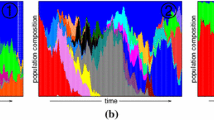Abstract
We discuss two models of molecular computing. The first one is based on an abstract formulation of two sorts of molecular reactions: enforcing and forbidden. The enforcing reactions are reactions that may happen, and are allowed to happen, in a given molecular system, while the forbidden reactions are detrimental for the system (e.g., leading to “incorrect” computations) and thus must be avoided. Hence computations in such a forbidding-enforcing system are driven by enforcing conditions (describing the enforcing reactions), but they are restrained by forbidding conditions (describing the forbidden reactions). The second model, called molecular landscapes, is geared towards the display of solutions. It consists of organisms (computing agents) functioning in a common environment which plays the role of a common communication medium for the organisms. When a molecular landscapes system works on a specific computational problem, each organism is working on this problem. But as soon as an organismM will get its solution to the problem, it modifies the environment, which from this moment on supports only the organisms that get the same solution asM. This is done through a selection mechanism that relies on selective competition which “kills” the losers. Since this selection mechanism interacts with the solution mechanism from the moment that computations are initiated, it can drastically increase the density of good solutions (molecules). In this way the molecular landscapes system achieves the goal of displaying solutions.
Similar content being viewed by others
References
Adleman, L.M., “Molecular computation of solutions to combinatorial problems,”Science 226, pp. 1021–1024, November 1994.
Ehrenfeucht, A., Rozenberg, G. and van Vugt, N.,Molecular landscapes, manuscript.
Ehrenfeucht, A., Hoogeboom, H. J., Rozenberg, G. and van Vugt, N., “Forbidding and Enforcing,”DNA Based Computers V (Winfree E. and Gifford, D.K., eds.), DIMACS Series in Discrete Mathematics 54, 2000.
Ehrenfeucht, A., Hoogeboom, H. J., Rozenberg, G. and van Vugt, N., “Sequences of Languages in Forbidding-enforcing Families,”Soft Computing 5, pp. 121–125, 2001.
Ehrenfeucht, A. and Rozenberg, G., “Forbidding-enforcing Systems,”Theoretical Computer Science, to appear.
Head, T., “Formal Language Theory and DNA: An Analysis of the Generative Capacity of Specific Recombinant Behaviours,”Bulletin of Mathematical Biology, 49, pp. 737–759, 1987.
Lewis, H. R. and Papadimitriou, C. H.,Elements of the Theory of Computation, Prentice Hall, Upper Saddle River, 1987.
Păun, Gh., “Computing with Membranes,”Journal of Computer and System sciences, 61, pp. 108–143, 2000.
Păun, Gh., Rozenberg, G. and Salomaa, A.,DNA Computing: New Computing Paradigms, Springer-Verlag, Berlin, Heidelberg, 1998.
van Vugt, N.,Models of Molecular Computing, Ph.D. Thesis, Leiden Institute of Advanced Computer Science, Leiden University, 2002.
Author information
Authors and Affiliations
Corresponding author
Additional information
Grzegorz Rozenberg, Ph.D.: He is a Professor, the Head of the Theory Group at Leiden Institute of Advanced Computer Science, and the Director of Leiden Center for Natural Computing at Leiden University, The Netherlands. He is also an Adjoint Professor of Computer Science at the Department of Computer Science, University of Colorado at Boulder, USA. He received his Engineering and Master degrees in computer science in 1965 from the Technical University of Warsaw, Poland, and his Ph.D. in mathematics in 1968 from the Polish Academy of Sciences, Warsaw, Poland. He has published about 400 papers, 5 books and edited over 50 books in formal language and automata theory, concurrent systems, graph theory and graph rewriting, computer supported cooperative work, and molecular computing. He is a performing magician, and he is possessed by paintings by Hieronymus Bosch. In his words: “I have a wonderful family, I have written many papers, I have shuffled many decks of cards, I have studied many paintings by Bosch. Life has been good to me.”
About this article
Cite this article
Rozenberg, G. Models of molecular computing based on molecular reactions. New Gener Comput 20, 237–249 (2002). https://doi.org/10.1007/BF03037358
Received:
Revised:
Published:
Issue Date:
DOI: https://doi.org/10.1007/BF03037358




